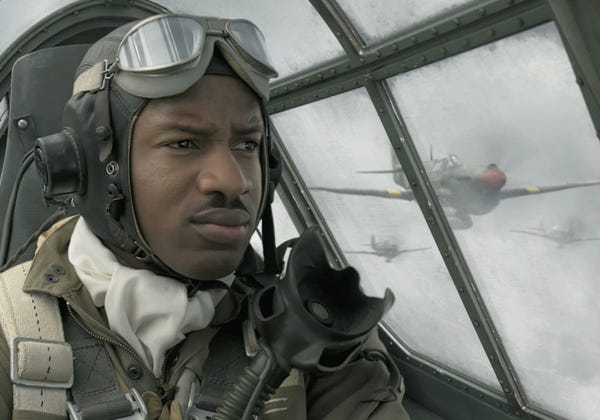Red Tails

“Red Tails” aims to dramatize, in heroic glory, the bravery of America’s first black aviators as they served in World War II. Unfortunately, heart is all that’s in the right place for executive producer George Lucas’s self-funded salute to these brave men.
Lucas has tried to make “Red Tails” for 25 years and openly chastised Hollywood’s skepticism to back a film whose appeal they felt was limited to black audiences. That’s why Lucas has reportedly plunked down nearly $100 million for production and distribution costs himself.
There is definitely sad truth to Lucas’s complaint. Great stories are great stories, regardless of their characters’ skin color, and those of the Tuskegee Airmen — fighter pilots whose protection on bombing runs has become WWII legend — are ripe for a rousing revisit. (Their missions were previously portrayed in HBO’s 1995 film “The Tuskegee Airmen.”)
Not all filmmakers have the financial wherewithal to pay for something like this themselves. However, most of them — having heard “no” so often — might step back and consider this constructive, if terse, criticism about the movie they want to make. Lucas has had his say, all the way, for 35 years. Unfortunately for the veterans whose stories could have made “Red Tails” soar, it shows.
The characterization represents a constant strafe of clichés. John Ridley and Aaron McGruder must have worn out their exclamation points typing the dialogue. Racism of the day is reduced to confrontations that leap from the pages of a comic book.
Transitions between its characters’ episodic adventures are sloppy. One particularly ADD segment jumps from a pilot’s marriage proposal to a botched POW escape to co-star Ne-Yo jollily playing guitar in about two minutes.
Most disappointing of all, at no point do we sense any human hesitancy in the guts of these men as they ascend to the air. Even our greatest heroes must swallow a modest amount of fear.
Finally, the overly pristine computer-generated dogfights in which they engage wring out any residual danger and tension there might have been. These combat scenes are like a fancy transparency laid over blueprints gone musty 50 years ago.
Ever the proponent for digital film, Lucas and director Anthony Hemingway have created images of spectacular brightness. But the film’s steroidal color palette brings a plasticity to even the earthbound sequences.
Initially, it’s hard to believe that much remains intact of the original script, credited to the men collectively responsible for “Three Kings,” “Undercover Brother” and “The Boondocks.” They’re not exactly known for pandering patter. But they’ve said they wanted a “John Wayne movie” of their own. “Red Tails” certainly matches the rickety rah-rah of The Duke’s war films but lacks a magnetic presence to push it through.
David Oyelowo, a British actor, tries hard as Joe “Lightning” Little, one of the film’s two leads. He’s the maverick counterpart to the straitlaced squad leader, Marty “Easy” Julian (Nate Parker, a dead ringer for a young Denzel Washington). Oyelowo carries as much of the film as he can with his hotheaded exuberance, and Parker goes toe-to-toe with him in a handful of ideologically combative scenes.
But aside from their brief scenes together, Parker and Oyelowo are washed out in hackneyed scenarios, as is their supporting cast of flyboys and mechanics (which includes Elijah Kelley, Tristan Wilds, Andre Royo, Michael B. Jordan and Method Man).
At some point, Lucas came aboard for reshoots that Hemingway was unable to complete. To his credit, it’s hard to spot the seams. Unfortunately, “Red Tails” needed more than reshoots. It needed a reexamination and revisions to bring something more than just good intentions to a great story.
